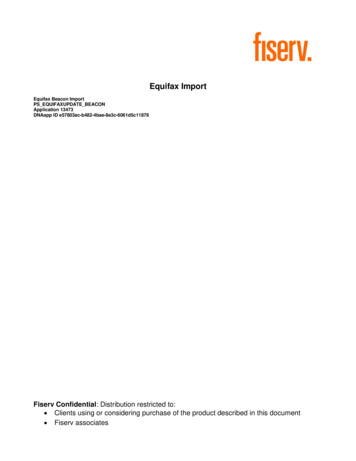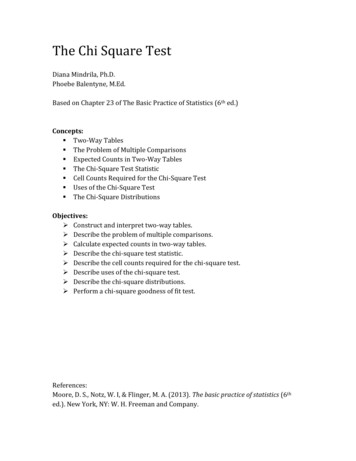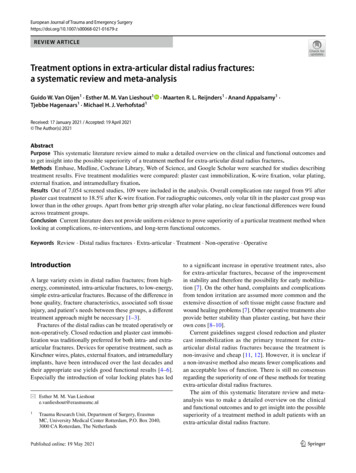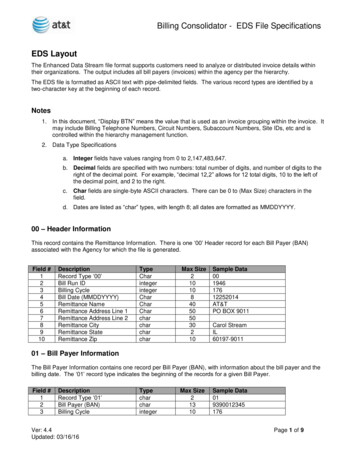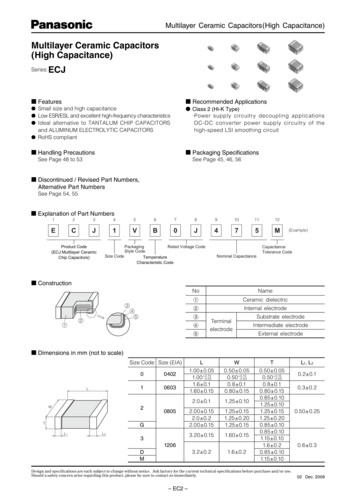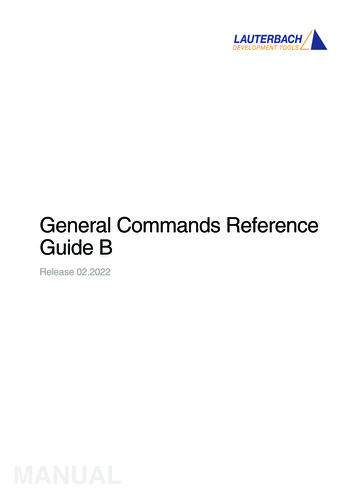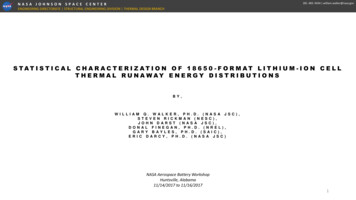
Transcription
281. 483. 0434 william.walker@nasa.govNASA JOHNSON SPACE CENTERENGINEERING DIRECTORATE STRUCTURAL ENGINEERING DIVISION THERMAL DESIGN BRANCHS TAT I S T I C A L C H A R A C T E R I Z AT I O N O F 1 8 6 5 0 - F O R M AT L I T H I U M - I O N C E L LT H E R M A L R U N A W AY E N E R G Y D I S T R I B U T I O N SBY ,W ILLIAM Q . W AL KE R, PH.D. ( NAS A JSC) ,ST EVEN RICKM AN ( NESC) ,JO HN DAR ST ( NAS A JSC) ,DO NAL FINEG AN, PH.D. ( NREL ) ,G ARY BAY LE S, PH.D. ( SAI C) ,ERIC DAR CY , PH.D. ( NAS A JSC)NASA Aerospace Battery WorkshopHuntsville, Alabama11/14/2017 to 11/16/20171
281. 483. 0434 william.walker@nasa.govNASA JOHNSON SPACE CENTERENGINEERING DIRECTORATE STRUCTURAL ENGINEERING DIVISION THERMAL DESIGN BRANCHB A C K G R O U N D : N A S A A N D B AT T E R I E S Lithium-ion (Li-ion) batteries are used for many aspects of human spaceflight:o Solar energy storage for the International Space Station (ISS)o Power supply during deep space exploration with Oriono Power supply to astronauts during extra-vehicular activities (EVAs)o Robotic applications (e.g. Robonaut 2)o Small electronics and portable devices Safety concerns exist for Li-ion battery utilization due to the inherentpossibility of thermal runaway (TR) NASA’s strategy for human spaceflight battery safety involves the following1,2:o Controls to prevent overcharge/discharge, over heating, and over currento Manufacturer audits and extensive cell screeningo Thermal management systems capable of preventing propagationo Updated the battery certification requirements to include the evaluationof TR severity and potential mitigation measures (20793 Rev D) To design optimized, high performance Li-ion battery assemblies that are safe,knowledge of the following are required 3:o Total energy output range during TR for a single Li-ion cello Fraction of the TR energy that is transferred through the cell casingo Fraction of the TR energy that is ejected through cell vent/burst paths1 NASA JSC-20793 Rev D (2017).2 Yayathi, S., et. al., Thermal Fluids and Analysis Workshop (2016).3 Darcy, E., et. al., Advanced Automotive Battery Conference (2017).4 Walker, W., Thermal Fluids and Analysis Workshop (2016).What cell should I select?How far apart should Ispace my cells?How much heat do Ineed to removefrom the localsystem?Do I need aninterstitial material?4How do I best protect theadjacent cells with minimaladditional mass / volumeHow do I support the designwith thermal analysis? What ismy simulated energydistribution?2
281. 483. 0434 william.walker@nasa.govNASA JOHNSON SPACE CENTERENGINEERING DIRECTORATE STRUCTURAL ENGINEERING DIVISION THERMAL DESIGN BRANCHB A C KG R O U N D : AVA I L A B L E C A L O R I M E T RY M E T H O D S Accelerating rate calorimetry (ARC) 5:o Very helpful in determining the onset temperature for TRo Due to the slow nature of ARC testing, cell venting occurshours before TRo Early venting dries out the electrolyteo Dried electrolyte possibly degrades the total heat outputo No practical means to discerning TR energy fractions Bomb or steel can calorimetry 6, 7:o Adequate for determining total heat outputo No practical means to discerning TR energy fractions Copper slug battery calorimetry 8:o Effective for measuring the heat output through the cell casingo Does not measure the heat output through the ejectao Estimates rate of mass ejected during TRo Must combine with bomb (steel can) calorimetry to calculateheat released through ejecta and gaso Again, no practical means to discern TR energy fractionsImage courtesy of Yayathi, et. al. 45 Yayathi, et. al., J. of Power Sources, 329 (2016) 197-206.6 Walters, R.N. and Lyon R.E., Report DOT/FAA/TC-15/40, March 2016.7 Jhu, C.Y., et. al., J. of Hazardous Materials, 192 (2011) 99-107.8 Liu, X., et. al., J. of Power Sources, 280 (2015) 516-525.3
NASA JOHNSON SPACE CENTER281. 483. 0434 william.walker@nasa.govENGINEERING DIRECTORATE STRUCTURAL ENGINEERING DIVISION THERMAL DESIGN BRANCHBAC KG RO U N D : N E W C A LO R I M E T RY M E T H O D NASA JSC team, in collaboration with the NESC, SAIC and NREL, developed a newTR calorimetry method capable of discerning the total heat output and thefractions of heat released through the cell casing vs. ejecta material:o Acknowledgement: NESC sponsored project Features of the new calorimeter:o Facilitates 18650-format Li-ion cellso Accommodates cell designs with bottom vents (BVs)o Uses high flux heaters to initiate TR quickly (i.e. relevant to field failure)o Simple operation enables multiple experiments per dayo Compatible with high speed X-ray videographyo Optional interface for measuring the gas exhaust heato Capable of mobile transport An Energy Yield Algorithm (EYA) was developed to automatically perform thefollowing post processing tasks:o Post process temperature vs. time for each calorimeter componento Calculate total heat output and determine the fractions of heat releasedthrough the cell casing vs. through the ejected material This presentation provides a statistical characterization of the TR behavior forseveral high energy (270 Wh kg-1) and moderate energy (200 Wh kg-1) Li-ion celldesigns tested in the calorimeter:o Other variables considered include bottom vent (BV), cell casing thickness, andinclusion of internal short circuit (ISC) deviceImage courtesy of Finegan, Donal and ESRF4
281. 483. 0434 william.walker@nasa.govNASA JOHNSON SPACE CENTERENGINEERING DIRECTORATE STRUCTURAL ENGINEERING DIVISION THERMAL DESIGN BRANCHDESCRIPTION OF CELLS TESTED Calorimetry experiments have been conducted at the NASA JSC Energy Systems Test Area (ESTA) and at the EuropeanSynchrotron Radiation Facility (ESRF):o 38 sets of data processed for successful tests processed to dateo 27 of the experiments were conducted using the ESRF in conjunction with the new calorimeter Normalization factors (ηEff) for each cell are provided in the results to allow direct comparison of total TR energy release:o ηEff (kJ kJ-1) is the ratio of stored electrochemical energy (kJ) to the total TR energy release (kJ) Note that NASA WI-033 recommends 10 tests per cell type to characterize the TR energy distributionItemUnitCapacity at 100% SOCAhNominal VoltageVStored Electrochemical Energy kJCell MassgSpecial Features TestedNumber of Successful TestsTest FacilityBV: Bottom Vent CellsNBV: Non-Bottom Vent CellsISC: Internal Short Circuit DeviceTCW: Thin Can WallS1 & S2: Two proprietary separatorsLG 18650-MJ13.433.6745.3479ESTA3.35 Ah LG 186503.353.744.647BV / ISC/ TCW22ESRFThis design is not yetcommercially availableSamsung 18650-30Q3.03.638.9483ESTAMolicel 18650-J2.33.7831.347Separator5ESRF5
281. 483. 0434 william.walker@nasa.govNASA JOHNSON SPACE CENTERENGINEERING DIRECTORATE STRUCTURAL ENGINEERING DIVISION THERMAL DESIGN BRANCHS TAT I S T I C A L A S S E S S M E N T: L G 1 8 6 5 0 - M J 1 3 . 4 3 A h 3 . 6 7 VItemTotal EnergyNormalization Factor (ηEff)Distribution ECell BodyDistribution EEjecta and Gas ( )Distribution EEjecta and Gas (-)Percent ECell BodyPercent EEjecta and Gas ( )Percent EEjecta and Gas (-)Time to TriggerCell Mass (Pre-TR)Cell Mass (Post-Tr)Pos. Ejecta Mating Soot Mass (Post-TR)Pos. Ejecta Bore Soot Mass (Post-TR)Neg. Ejecta Mating Soot Mass (Post-TR)Neg. Ejecta Bore Soot Mass (Post-TR)Estimated Mass Ejected from SystemUnitkJkJ kJ-1kJkJkJ%%%sgggggggSample Size: 4.615.70.20.815.4Std. Dev. Abs. Max Abs. 0.01.33.50.04.024.711.26
281. 483. 0434 william.walker@nasa.govNASA JOHNSON SPACE CENTERENGINEERING DIRECTORATE STRUCTURAL ENGINEERING DIVISION THERMAL DESIGN BRANCHS TAT I S T I C A L A S S E S S M E N T: L G 1 8 6 5 0 - M J 1 3 . 4 3 A h 3 . 6 7 V The LG 18650-MJ1 is the highest energy cell tested to date in the new calorimeter:o Comparison to results from lower energy cells indicates that higher energy cells tend to have more violent TR events and torelease a large fraction of the energy through the ejecta material and gases (on order of 80%)o Although more violent, less energy may be directed to the neighbor cells depending on failure mechanism Large standard deviation (8.8 kJ) makes 3-sigma (3-𝞂) / 6-sigma (6-𝞂) assessment impracticalEjecta and Gas (-)Total TR EnergyRelease Data PointCell BodyMean: 73.8 kJNormal DistributionCurveEjecta and Gas ( )Sample Size: 97
281. 483. 0434 william.walker@nasa.govNASA JOHNSON SPACE CENTERENGINEERING DIRECTORATE STRUCTURAL ENGINEERING DIVISION THERMAL DESIGN BRANCHS TAT I S T I C A L A S S E S S M E N T: 3 . 3 5 A h L G 1 8 6 5 0 3 . 3 5 A h 3 . 7 VItemTotal EnergyNormalization Factor (ηEff)Distribution ECell BodyDistribution EEjecta and Gas ( )Distribution EEjecta and Gas (-)Percent ECell BodyPercent EEjecta and Gas ( )Percent EEjecta and Gas (-)Time to TriggerCell Mass (Pre-TR)Cell Mass (Post-Tr)Pos. Ejecta Mating Soot Mass (Post-TR)Pos. Ejecta Bore Soot Mass (Post-TR)Neg. Ejecta Mating Soot Mass (Post-TR)Neg. Ejecta Bore Soot Mass (Post-TR)Estimated Mass Ejected from SystemUnitkJkJ kJ-1kJkJkJ%%%sgggggggSample Size: 3.00.69.90.22.311.4Std. Dev. Abs. Max Abs. .50.02.88.80.02.419.38.1Impacts ofcells with BVand TCW8
281. 483. 0434 william.walker@nasa.govNASA JOHNSON SPACE CENTERENGINEERING DIRECTORATE STRUCTURAL ENGINEERING DIVISION THERMAL DESIGN BRANCHS TAT I S T I C A L A S S E S S M E N T: 3 . 3 5 A h L G 1 8 6 5 0 3 . 3 5 A h 3 . 7 V The 3.35 Ah LG 18650 is a development cell where several features were considered:o Results below combine standard cell, BV cell, ISC cells, TWC cells and combinations of eacho Same chemistry, so direct comparison of TR energy provided belowo Inclusion of bottom vent cells makes assessment of energy fraction not possible at this level (requires sort, see next slide ) Like with the MJ1, the large standard deviation (5.1 kJ) makes 3-𝞂 / 6-𝞂 assessment impractical:o Lower standard deviation than the MJ1 tests (5.1 kJ vs. 8.8 kJ)Total TR EnergyRelease Data PointMean: 63.4 kJNormal DistributionCurveSample Size: 229
281. 483. 0434 william.walker@nasa.govNASA JOHNSON SPACE CENTERENGINEERING DIRECTORATE STRUCTURAL ENGINEERING DIVISION THERMAL DESIGN BRANCHS TAT I S T I C A L A S S E S S M E N T: 3 . 3 5 A h L G 1 8 6 5 0 ( B V V S . N B V ) BV cells had a tighter distribution (more predictable) of total TR energy release NBV cells had a higher total TR energy release, larger distribution (less predictable), and more mass loss:o Possibly due to the increased “violence” associated with non-BV TR events Counter-intuitively, BV cells typically had a higher remaining cell mass Standard deviation for BV and NBV makes 3-𝞂 / 6-𝞂 assessment impractical (2.6 kJ and 5.1 kJ, respectively)Total TR EnergyRelease Data PointBottom VentMean: 60.7 kJNormal DistributionCurveTotal TR EnergyRelease Data PointMean: 68.1 kJNo Bottom VentCell BodyEjecta and Gas ( )Ejecta and Gas (-)Normal DistributionCurve10
281. 483. 0434 william.walker@nasa.govNASA JOHNSON SPACE CENTERENGINEERING DIRECTORATE STRUCTURAL ENGINEERING DIVISION THERMAL DESIGN BRANCHS TAT I S T I C A L A S S E S S M E N T: 3 . 3 5 A h L G 1 8 6 5 0 ( B V V S . N B V ) BV cells had a tighter distribution (more predictable) of total TR energy release NBV cells had a higher total TR energy release, larger distribution (less predictable), and more mass loss:o Possibly due to the increased “violence” associated with non-BV TR events Counter-intuitively, BV cells typically had a higher remaining cell mass Standard deviation for BV and NBV makes 3-𝞂 / 6-𝞂 assessment impractical (2.6 kJ and 5.1 kJ, respectively)Total TR Energy Release Vs. Mass Loss: BVItemUnit XR-Run2Total EnergykJ64.2-1Electrochemical Ratio kJ kJ1.42Cell Mass (Pre-TR)g47.3Cell Mass (Post-Tr)g20.1XR-Run3 XR-Run4 XR-Run5 XR-Run6 XR-Run7 XR-Run8 XR-Run9 XR-Run12 XR-Run13 XR-Run16 XR-Run18 XR-Run19 XR-Run22 Average Std. .628.028.423.925.023.825.327.322.525.22.5Total TR Energy Release Vs. Mass Loss: NBVItemUnit XR-Run10Total EnergykJ66.1Electrochemical Ratio kJ kJ-11.46Cell Mass (Pre-TR)g47.3Cell Mass 719.2Std. Dev.5.10.110.33.2LG cell with BV before (left) andafter (right) vent/burst testing9 Darcy, E., et. al., S&T Meeting, San Diego, CA. (2016).Image courtesy of Darcy, E., et. al. 911
281. 483. 0434 william.walker@nasa.govNASA JOHNSON SPACE CENTERENGINEERING DIRECTORATE STRUCTURAL ENGINEERING DIVISION THERMAL DESIGN BRANCHS TAT I S T I C A L A S S E S S M E N T: S A M S U N G 1 8 6 5 0 - 3 0 Q 3 . 0 A h 3 . 6 VItemTotal EnergyNormalization Factor (ηEff)Distribution ECell BodyDistribution EEjecta and Gas ( )Distribution EEjecta and Gas (-)Percent ECell BodyPercent EEjecta and Gas ( )Percent EEjecta and Gas (-)Time to TriggerCell Mass (Pre-TR)Cell Mass (Post-Tr)Pos. Ejecta Mating Soot Mass (Post-TR)Pos. Ejecta Bore Soot Mass (Post-TR)Neg. Ejecta Mating Soot Mass (Post-TR)Neg. Ejecta Bore Soot Mass (Post-TR)Estimated Mass Ejected from SystemUnitkJkJ kJ-1kJkJkJ%%%sgggggggSample Size: .821.20.00.016.5Std. Dev. Abs. Max Abs. 00.00.01.918.715.212
281. 483. 0434 william.walker@nasa.govNASA JOHNSON SPACE CENTERENGINEERING DIRECTORATE STRUCTURAL ENGINEERING DIVISION THERMAL DESIGN BRANCHS TAT I S T I C A L A S S E S S M E N T: S A M S U N G 1 8 6 5 0 - 3 0 Q 3 . 0 A h 3 . 6 V Only 3 runs conducted so far for the Samsung 30Q:o Efforts in work to conduct 7 more tests to complete the assessment of the cell Again, the higher energy cells demonstrates a significant fraction of energy released through the ejecta Standard deviation (2.5 kJ) still makes 3-𝞂 / 6-𝞂 assessment impractical; could grow larger as more cells are tested Total TR energy release may not be directly proportional to stored electrochemical energy:o Consider the Samsung 30Q energy compared to other cells when normalized to electrochemical energyo Samsung 30Q had a higher normalization factor (ηEff of 1.54) than the 3.35 Ah LG 18650 (ηEff of 1.4)Cell BodyTotal TR EnergyRelease Data PointMean: 59.9 kJNormal DistributionCurveEjecta and Gas ( )Sample Size: 313
281. 483. 0434 william.walker@nasa.govNASA JOHNSON SPACE CENTERENGINEERING DIRECTORATE STRUCTURAL ENGINEERING DIVISION THERMAL DESIGN BRANCHS TAT I S T I C A L A S S E S S M E N T: M O L I C E L 1 8 6 5 0 - J 2 . 3 A h 3 . 7 8 VItemTotal EnergyNormalization Factor (ηEff)Distribution ECell BodyDistribution EEjecta and Gas ( )Distribution EEjecta and Gas (-)Percent ECell BodyPercent EEjecta and Gas ( )Percent EEjecta and Gas (-)Time to TriggerCell Mass (Pre-TR)Cell Mass (Post-Tr)Pos. Ejecta Mating Soot Mass (Post-TR)Pos. Ejecta Bore Soot Mass (Post-TR)Neg. Ejecta Mating Soot Mass (Post-TR)Neg. Ejecta Bore Soot Mass (Post-TR)Estimated Mass Ejected from SystemUnitkJkJ kJ-1kJkJkJ%%%sgggggggSample Size: 70.92.70.20.09.3Std. Dev. Abs. Max Abs. 00.00.00.00.710.28.514
281. 483. 0434 william.walker@nasa.govNASA JOHNSON SPACE CENTERENGINEERING DIRECTORATE STRUCTURAL ENGINEERING DIVISION THERMAL DESIGN BRANCHS TAT I S T I C A L A S S E S S M E N T: M O L I C E L 1 8 6 5 0 - J 2 . 3 A h 3 . 7 8 V Only 5 runs conducted so far for the Molicel 18650-J:o Two proprietary separator materials considered Lower energy cell released more energy through the casing of the cell:o The Molicel TR event took longer for the calorimeter to register max energy which lead to ”leach” heat to the negative sidecalorimeter components; this leach heat gives the appearance of bottom rupture on the pie chart Magnitude of standard deviation (4.2 kJ) still makes 3-𝞂 / 6-𝞂 assessment impracticalEjecta and Gas (-)Total TR EnergyRelease Data PointCell BodyMean: 35.5 kJNormal DistributionCurveEjecta and Gas ( )Sample Size: 515
281. 483. 0434 william.walker@nasa.govNASA JOHNSON SPACE CENTERENGINEERING DIRECTORATE STRUCTURAL ENGINEERING DIVISION THERMAL DESIGN BRANCHS TAT I S T I C A L A S S E S S M E N T : C O M B I N E D C O M PA R I S O N The predictability of TR behavior decreases as energy density increases:o The 2.3 Ah Molicel 18650-J cells had the smallest standard deviation (4.2 kJ), the 3.35 Ah LG 18650 cells had slightly higherstandard deviation (5.1 kJ), while the 3.43 Ah LG 18650-MJ1 had the highest standard deviation (8.8 kJ)o The Samsung 18650-30Q standard deviation is excluded here due to small sample size (3)o Indicates that higher energy cells have more severe TR events which are generally less predictable However, the introduction of the BV to higher energy cells disrupts the previously described behavior (refer to Chart 10):o After excluding the non-BV versions, the 3.35 Ah LG 18650 cells with BV, had the lowest standard deviation of 2.6 kJo Suggests that the predictability of higher energy cells can be improved with inclusion of BVMean: 35.5 kJMolicel 18650 –J3.35 Ah LG 18650LG 18650-MJ1Samsung 18650-30QMean: 59.9 kJMean: 63.4 kJMean: 73.8 kJ16
NASA JOHNSON SPACE CENTER281. 483. 0434 william.walker@nasa.govENGINEERING DIRECTORATE STRUCTURAL ENGINEERING DIVISION THERMAL DESIGN BRANCHCONCLUSION New calorimetry method that was used for the testing that these results are generated from enables the discernment of thefractions of TR energy released through the cell casing and through the ejecta material Results provide the means to develop optimized Li-ion batteries while also maintaining safety aspects and margin Thermal analysis efforts could consider the following options:o First, consider the impacts of 100% worst case TR energy released through the cell casingo Second, consider 100% of the highest probability TR energy released through the cell casingo Third, consider the worst case fraction of the worst case TR energy released through the cell casingo Fourth, consider the average cell casing fraction of the highest probability TR energy released through the cell casing Thermal analysis could also consider a 3-σ or 6-σ approach if fractions are assumed:o First, consider the impacts of worst case cell casing fraction coupled with 6-σ TR energy releaseo Second, consider the impacts of worst case cell casing fraction coupled with 3-σ TR energy release Although the total TR energy release is related to the stored electrochemical energy, it may not be directly proportional (e.g.comparison of the LG 18650-MJ1 to the Samsung 18650-30Q TR characteristics):o Cells of varying chemistry and materials have different TR energy release probabilities (slide 20) BV cells consistently released less TR energy ( 10 kJ for 3.35 Ah LG cell) and have higher post TR cell mass than non-BV cells:o This all indicates a less severe TR event as an effect of the BV featureo Battery designers should be ready to accommodate and take advantage of cell designs with the BV feature in the future Higher energy cells tend to eject more material during TR:o Results in less energy associated with the cell body and more energy associated with the ejecta NASA WI-033 recommends 10 calorimeter experiments to characterize the TR behavior of a given cell17
DESCRIPTION OF CELLS TESTED 5 Item Unit LG 18650-MJ1 3.35 Ah LG 18650 Samsung 18650-30Q Molicel 18650-J Capacity at 100% SOC Ah 3.43 3.35 3.0 2.3 Nominal Voltage V 3.67 3.7 3.6 3.78 Stored Electrochemical Energy kJ 45.3 44.6 38.9 31.3 Cell Mass g 47 47 48 47 Special Features Tested - - BV / ISC/ TCW - Separator Number of Successful Tests - 9 22 3 5 Test Facility - ESTA ESRF ESTA ESRF

